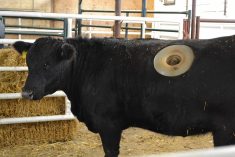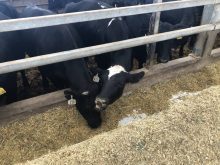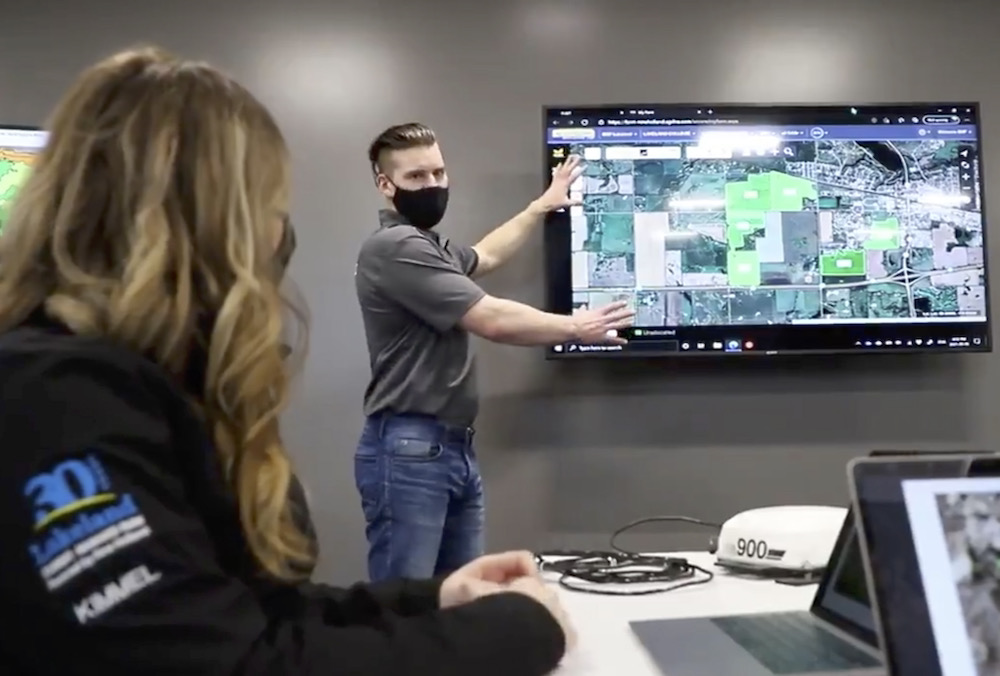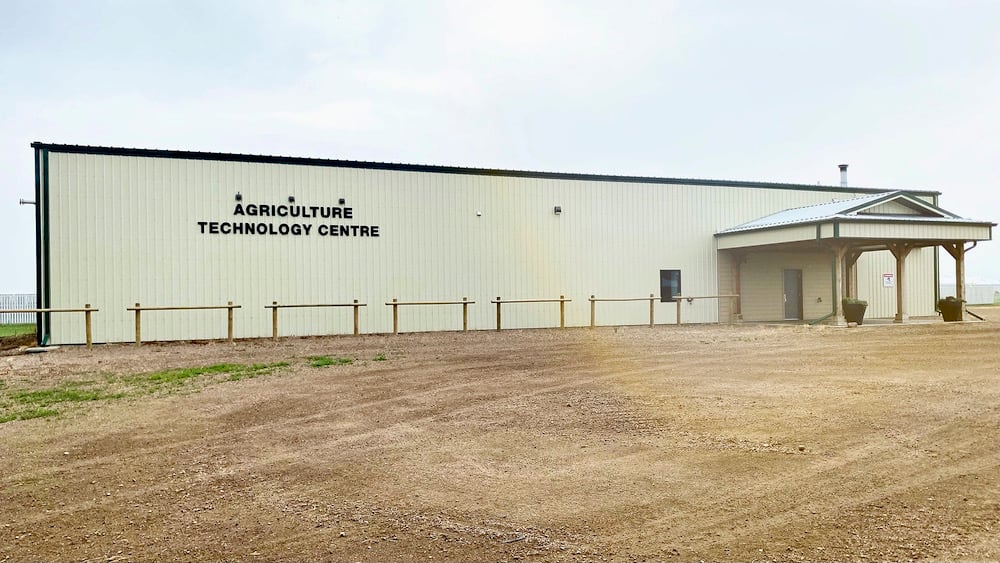Within the first week of being back on campus and starting the classes I knew this is where I wanted to be. I feel like I’ve learned more in the sixth week of being here than I have in the last six weeks of any other part of my education.”
So said Courtney Wallace, a student in Lakeland College’s brand new bachelor of agriculture technology program. These have been an exciting couple of months at the Vermilion-based college. Not only has the bachelor’s program — billed as the first of its kind in Canada — launched, but September also saw the grand opening of its Agriculture Technology Centre, the hub of the program where data from the campus’s student-managed farm will be collected and processed.
Read Also

Moo translator and methane measures: There’s an app for that
Dalhousie University researchers use artificial intelligence to create new dairy farm apps that analyze cattle sounds and measure methane.
“The whole point of the program is we’d like these students to be the data and technology experts for our student-managed farm,” said Josie Van Lent, dean of agriculture technology and applied research.
The program was designed with extensive input from the ag industry, she said. Although graduates will be qualified for a broad range of positions tied to smart farm tech, one of the biggest things stressed by industry partners was the need for future “integrators” who speak tech as easily as they speak ag.
“The industry needs people who can speak the language of the people who are developing and providing the technology as well as speak the language of the producers,” said Kyle Kipps, program head and instructor for the agriculture technology (ag tech for short) program.
Kipps said the opening of the Ag Tech Centre and the launch of the degree program coincide at a pivotal time when precision technology is playing an increasingly central role in agriculture.
“In the previous revolutions in agriculture, we’ve seen the domestication of crops, the utilization of animal power, the mechanization of farms with machinery and the Green Revolution of fertilizer and crop protection products. This latest iteration is the age of technology and digital farming.”
Wallace, who hails from a multi-generational purebred and commercial Hereford operation in Farmington, B.C., is confident that graduation from the program will give her career an early boost. She plans to take her knowledge home with her to help producers in her community better succeed with smart farm precision tech.
“I really do think that this program is going to set all the students involved in the program up for success in the future no matter what field they enter. Last year when I heard about this opportunity I knew I wanted to continue my education so that when I complete this degree I’ll be able to go back to my hometown and start bringing in a better influence on how to create a more sustainable future within the livestock industry.”
A space for innovation and tinkering
The Agriculture Technology Centre is a 743-square-metre facility featuring a technology hub — the Lewis Farm Data Lab — with displays and analytical tools, a combined lab and classroom space and an area for large farm equipment demonstrations and training.
“We have the ability and the space there to easily wheel in something as large as a combine, have it indoors for the winter months where it’s warm, and we can open the doors and look at the sensors and other components of tech on that piece of equipment,” Kipps said.
Data from all of the units on the student-managed farm feeds into the data lab. These data sources include in-field monitors, sensors, cameras, and precision technologies embedded across the campus farm. It’s also where livestock, field, crop and agronomic maps and collected data are interpreted, analyzed and packaged.
“It’s an opportunity for students to work on the analysis and try to come up with some of their management decision-making from that data.”
The agriculture technology lab has a “makerspace” component. It’s a collaborative workspace used for problem solving and developing a range of creative solutions.
“If there was a need or opportunity — a problem to be solved — the students could work on prototyping or developing or disassembling whatever they need to learn the concept we’re looking at. The college also has several 3D printers that we have access to. It’s space for innovation and tinkering.”
Starting in the field
The students hadn’t done much inside the Ag Tech Centre as of the middle of October, instead spending most of their time flying data-collecting drones and learning about the various sensors in the field while the weather was still good.
“We’ve been out in the field for basically all our labs,” said Tyson Miazga, a student from Saskatoon.
“In our last lab we went over SWAT maps and learned about how they’re used and how they can tell you about your soil type, the nutrient levels, salinity and pH and how you can predict how a crop will yield in each zone and when and how they’ll react to certain nutrient applications.”
Miazga — whose goal is to work for a tech company after graduation — said he can’t wait to delve deep into the technology side of the centre.
“It’s pretty exciting being able to bring a piece of equipment into the shop and actually go through all the components — for example the GPS and how it sends and receives signals. Learning how (the GPS) works with the satellites and control segments and user segments are all beneficial to know in the industry. If producers are having issues we could easily be able to help them out just by having hands-on experience with the college.”
Sustainability a motivation
Almost any precision technology has been driven by the broad concept of sustainability — in this case, the twin but related desires of keeping the land viable while increasing farm profitability.
Sustainability was a force behind both students’ decisions to focus their educations on ag tech.
“I think sustainability is probably one of the most important parts of agriculture just because if you aren’t sustainable throughout generations of agriculture, there’s going to be nothing for this next generation to farm,” Miazga said.
“With the technology coming up it’s making it easier to realize certain things that you might have been doing in the past aren’t the best practices and you can react now and change them so we can still farm in the future generations whether it’s 50, 100 or 200 years down the road.”
Wallace said she has seen cattle operations fold due to a lack of focus on sustainability.
“When I look at cattle and grazing, that’s a large part of the ecosystem and if you don’t manage sustainably, things are going to go down so fast. I’ve seen people’s farms go down because of that and that’s the main reason why I want to be here and I want to learn so that we can continue to keep a sustainable ecosystem for the next generation.”
A chance for a degree
The admission protocol of the bachelor of agriculture technology program is based on “laddering” from existing credentials. The direct-entry route involves receiving a select agriculture diploma from Lakeland, Olds or Lethbridge colleges, while indirect entry may recognize an ag-related diploma or degree from a different institution.
Wallace previously graduated from Lakeland College with an animal science technology degree with a major in beef, while Miazga completed a diploma of agriculture management with a major in crop science at Olds College.
“Alberta Advanced Education is really encouraging approaches other than the traditional models where you have a four-year degree and it’s four years at that institution,” Van Lent said.
“We’re really proud of the fact we’re providing opportunities for students who haven’t taken a traditional degree to get one. We want to recognize prior learning. So someone perhaps has been out in the workforce for 25 years and has a diploma from way back when. We’ll have a look at what they’ve been working on and whether that prior learning will allow them to be successful in our degree.”
















